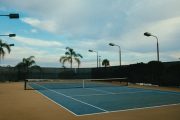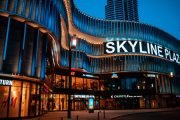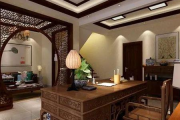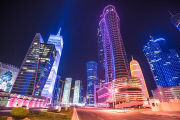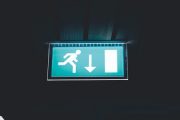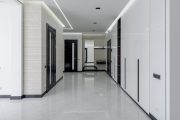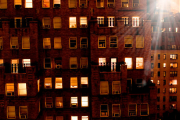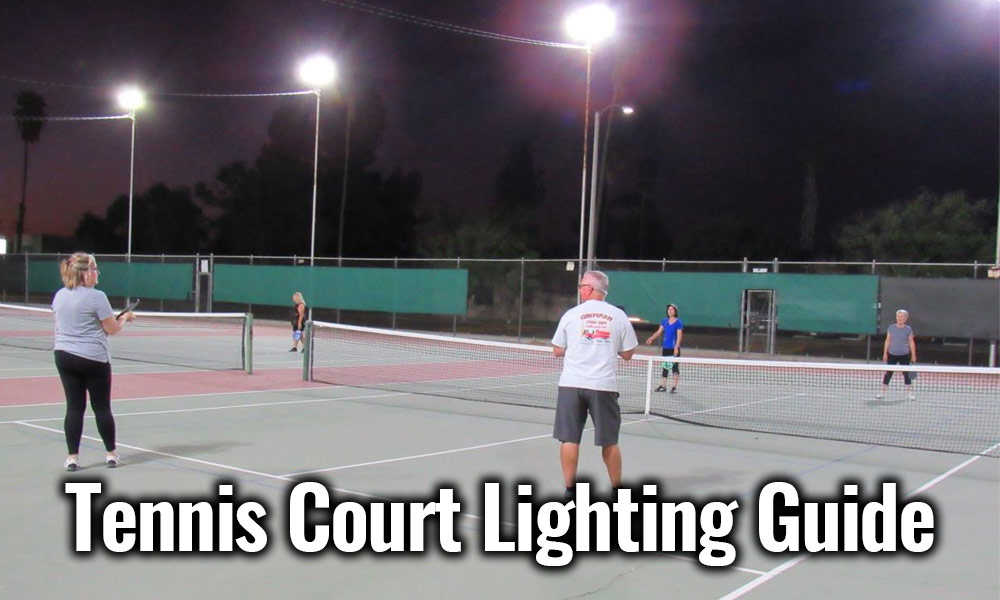
The layout of a standard tennis court is not less than 36.58 meters (length) x 18.29 meters (width). This size is also the net size of a net around the standard tennis court or the interior wall of an indoor building. In this area, the standard size of an effective doubles floor is: 23.77 meters (length) x 10.97 meters (width), and there should be no less than 3.66 meters of open space behind each end line.
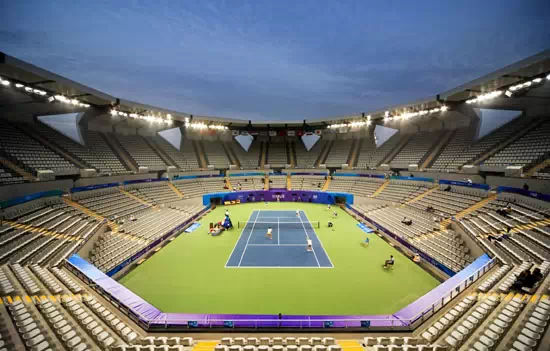 Install a net post on the court. The distance between the two posts is 12.80 meters. The top of the net post is 1.07 meters from the ground plane, and the top edge of the net is 0.914 meters from the ground plane. In the case of two or more adjacent parallel tennis courts, the distance between the edges of adjacent courts shall not be less than 5 meters.
Install a net post on the court. The distance between the two posts is 12.80 meters. The top of the net post is 1.07 meters from the ground plane, and the top edge of the net is 0.914 meters from the ground plane. In the case of two or more adjacent parallel tennis courts, the distance between the edges of adjacent courts shall not be less than 5 meters.
Tennis court types
Tennis courts can be divided into outdoor and indoor courts, and there are various court surfaces. It will be determined by economic factors. For example, lawn tennis is the most basic outdoor field, but its establishment and maintenance costs are too expensive, so it is now replaced by artificial courts, which are cheaper and easier to maintain. There is also a clay court popular in Europe, the French Open is such a course.
1. Outdoor tennis court
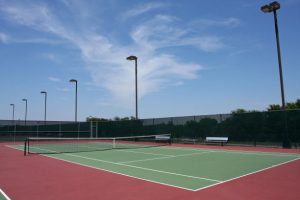 1.The height of the nets around the outdoor tennis court is generally between 4-6 meters. Depending on the environment and height of the building, it can be increased or decreased appropriately. For stadiums that need to be installed with lighting, except for the distribution of indoor roof lamps, there should be no lamps on the outdoor court and on both sides of the end line. Outdoor court lamps should be set on the sides of the nets above 6 meters above the ground, and the lights are evenly illuminated from the scene on both sides of the court.
1.The height of the nets around the outdoor tennis court is generally between 4-6 meters. Depending on the environment and height of the building, it can be increased or decreased appropriately. For stadiums that need to be installed with lighting, except for the distribution of indoor roof lamps, there should be no lamps on the outdoor court and on both sides of the end line. Outdoor court lamps should be set on the sides of the nets above 6 meters above the ground, and the lights are evenly illuminated from the scene on both sides of the court.
Conventional lighting method for outdoor tennis court
(1) Arrangement at four corners: The combination of lamps and centralized forms and light poles is arranged at the four corners of the playing field.
(2) Mixed arrangement: The two-sided arrangement is combined with the four-cornered arrangement.
(3) Arrangement on both sides: The lamps and lanterns are combined with light poles or building tracks, and are arranged on the sides of the playing field in the form of continuous light bands or clusters.
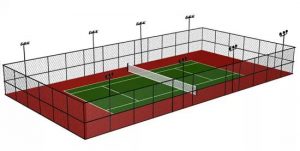 Outdoor tennis court lighting scheme one: cloth light mode: pole lights on both sides of the court; number of cloth lights: 4 groups; each group configuration: 8 meters tapered steel light pole 2 400W xenon extremely bright series; two on one side Light spacing: 16 meters; average ground illumination: 420 Lux; this program is mainly applicable to: general training, entertainment and other ordinary tennis venues, such as: community activity centers, factory tennis courts, community and so on.
Outdoor tennis court lighting scheme one: cloth light mode: pole lights on both sides of the court; number of cloth lights: 4 groups; each group configuration: 8 meters tapered steel light pole 2 400W xenon extremely bright series; two on one side Light spacing: 16 meters; average ground illumination: 420 Lux; this program is mainly applicable to: general training, entertainment and other ordinary tennis venues, such as: community activity centers, factory tennis courts, community and so on.
2. Indoor tennis court
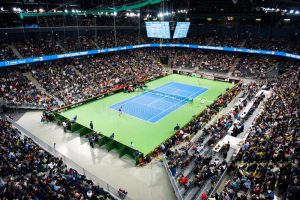 For indoor tennis courts, the clear height above the end line 6 40 meters is not less than 6.40 meters, and the clear height of the indoor roof above the net is not less than 11.50 meters. However, according to the company’s multi-site surveys, a standard tennis court covers an area of not less than 36.6 meters x 18.3 meters beyond the end line of 6.40 meters. The clear height of the sky is not less than 6.40 meters. Most domestic indoor tennis stadiums are constructed of steel structures. The roof is made of steel structure, ranging from 7-12 meters in height, most of which are 8 meters and 9 meters. The installation height of the lamps is generally about 7-10 meters. The scheme involves related formulas and parameters: the formula that simulates the lighting effect supports E = Medium NKCUIA, where E represents the average illuminance 4 represents the total luminous flux of a single lamp N–the total number of lamps K-maintenance coefficient: along with the reflector and glass Pollution, and light decay, etc., after a period of use, the illuminance will be relatively reduced, so it must be estimated first. According to the site environment, the maintenance factor of the lamp is less than 1: The luminous flux utilization factor emitted by Cu-lamp Take the value according to the site environment.
For indoor tennis courts, the clear height above the end line 6 40 meters is not less than 6.40 meters, and the clear height of the indoor roof above the net is not less than 11.50 meters. However, according to the company’s multi-site surveys, a standard tennis court covers an area of not less than 36.6 meters x 18.3 meters beyond the end line of 6.40 meters. The clear height of the sky is not less than 6.40 meters. Most domestic indoor tennis stadiums are constructed of steel structures. The roof is made of steel structure, ranging from 7-12 meters in height, most of which are 8 meters and 9 meters. The installation height of the lamps is generally about 7-10 meters. The scheme involves related formulas and parameters: the formula that simulates the lighting effect supports E = Medium NKCUIA, where E represents the average illuminance 4 represents the total luminous flux of a single lamp N–the total number of lamps K-maintenance coefficient: along with the reflector and glass Pollution, and light decay, etc., after a period of use, the illuminance will be relatively reduced, so it must be estimated first. According to the site environment, the maintenance factor of the lamp is less than 1: The luminous flux utilization factor emitted by Cu-lamp Take the value according to the site environment.
Indoor tennis lighting arrangement
1.Direct lighting fixture arrangement
(1) Arrangement at the top the lamps are arranged above the site, and the light beam is arranged perpendicular to the site plane.
(2) Arranged on both sides the lamps are arranged on both sides of the site, and the light beam is not arranged perpendicular to the plane of the site.
(3) Mixed arrangement the combination of the top arrangement and the two arrangement.
2.The specific arrangement should meet the following requirements for use
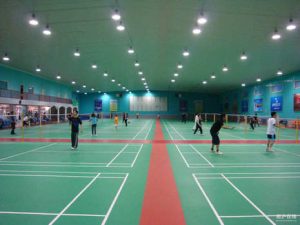 Tennis usually moves at high speed in a short distance, and the direction of the ball needs to be judged in a short time. Therefore, tennis requires high visual effects. The layout of the indoor tennis court lights used for formal matches should not be above the ppa (basic game area). Arrange lamps and lanterns. If there are stadium lights above the ppa, bright light sources will bring serious glare to the players. Therefore, tennis lighting should be placed in a space outside the ppa. In addition, the installation height of the lamp outside the net is not less than 9.144m; at the bottom line, the height of the lamp should not be less than 9.096m. Indoor tennis courts can generally be equipped with tennis court lights at more suitable positions on both sides of the court, or you can directly install lamps on the indoor ceiling. If the ceiling cloth light method is used, the ceiling is a diffuse reflection ceiling or a grid ceiling, and the light is illuminated on the ceiling. Then through the ceiling light transmission to achieve the lighting effect. According to cie42 illumination, the indoor tennis court is 300lx in the entertainment mode; 500lx in the training mode; and 750lx in the competition mode. One of the reasons why there is a difference in illumination requirements between indoor and outdoor is to limit the brightness contrast between the playing field and the surrounding environment.
Tennis usually moves at high speed in a short distance, and the direction of the ball needs to be judged in a short time. Therefore, tennis requires high visual effects. The layout of the indoor tennis court lights used for formal matches should not be above the ppa (basic game area). Arrange lamps and lanterns. If there are stadium lights above the ppa, bright light sources will bring serious glare to the players. Therefore, tennis lighting should be placed in a space outside the ppa. In addition, the installation height of the lamp outside the net is not less than 9.144m; at the bottom line, the height of the lamp should not be less than 9.096m. Indoor tennis courts can generally be equipped with tennis court lights at more suitable positions on both sides of the court, or you can directly install lamps on the indoor ceiling. If the ceiling cloth light method is used, the ceiling is a diffuse reflection ceiling or a grid ceiling, and the light is illuminated on the ceiling. Then through the ceiling light transmission to achieve the lighting effect. According to cie42 illumination, the indoor tennis court is 300lx in the entertainment mode; 500lx in the training mode; and 750lx in the competition mode. One of the reasons why there is a difference in illumination requirements between indoor and outdoor is to limit the brightness contrast between the playing field and the surrounding environment.
(1) Symmetrical light distribution lamps should be used on the top layout, which is suitable for gyms that mainly use low space, have higher requirements on ground level illumination uniformity, and do not have television broadcasting requirements.
(2). Asymmetrical light distribution lamps should be used for the lighting on both sides, and they should be arranged on the road. It is suitable for sports halls with high vertical illumination requirements and television broadcasting requirements. When lights are arranged on both sides, the aiming angle of the lamp should not be greater than 65 degrees.
(3) The mixed arrangement should choose a variety of light distribution lamps, which are suitable for large comprehensive stadiums. For the arrangement of the lamps, see the layout on the top and the layout on both sides.
(4) According to the arrangement of bright lamps, medium and wide beam light distribution lamps should be used, which is suitable for building spaces with low floor heights, large spans and good top grid reflection conditions. It is also suitable for stricter glare restrictions and no TV. The stadium required for the broadcast is not applicable to the hanging light fixtures and the building structure installed with the horse track.
(5) The indoor tennis court lighting cloth lights should be parallel to both sides of the court, the total length of the arrangement should not be less than 36 meters, the aiming of the lamps should be perpendicular to the longitudinal centerline of the court, and the accuracy of the lamps should not be greater than 65 degrees.
Tennis court Illumination standard
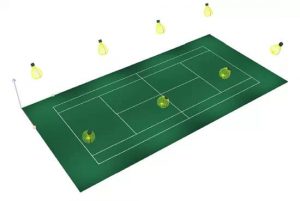
Tennis court lights require relatively high light levels. Be sure to choose anti-glare lamps. This light level is measured from 1 meter above the court. If the lighting of the tennis court of a regular match should also meet the requirements of TV broadcasting, Energy-saving professional design is required. The way of installing lights is different in different venues.
The standard is to determine the lighting standard according to the function of the court, which is roughly divided into the following levels:
Illumination of training and entertainment activities 120-300lx; amateur competitions 300-500lx; professional competitions 500-800lx; general TV broadcast ≥1000lx; large-scale international high-definition television broadcast 1400lx, tv emergency 750lx.
Common lighting fixtures for tennis courts-metal halide and LED lights
The average tennis court’s light source uses metal halide lamps and LED lights, traditional tennis courts-generally uses metal halide lamps, with LED lights
There are many tennis courts that use LED professional court lights. However, in response to the country’s request to establish an energy-saving and emission-reducing society, LED lighting has begun to enter people’s sight quickly. As an energy-saving lighting device, LED has received increasing attention. More and more tennis courts replace traditional metal halide lamps with LED lighting
Why LED lights can replace metal halide lamps
Comparison between traditional metal halide lamps and LED lamps
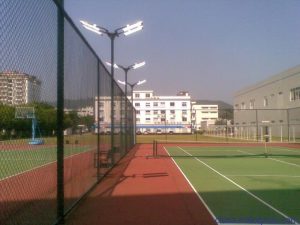 1. Light source characteristics
1. Light source characteristics
1. LED is called the fourth generation of energy-saving lighting products, environmental protection: no mercury, no UV.
2. Energy saving: high light efficiency, current mass production reaches 1601m / w. Long life: 70% lumen maintenance
3. The rate of life reaches 36,000 hours. Not afraid of vibration, it can realize dimming and intelligent control.
4. Metal halide lamps are high-gas discharge lamps. The area of the luminous body is small, and the light is concentrated and illuminated.
5. Long distance, strong penetration, but light color is slightly worse, slow start, high UV content,
2. Comparison of LED and metal halide lamp indicators
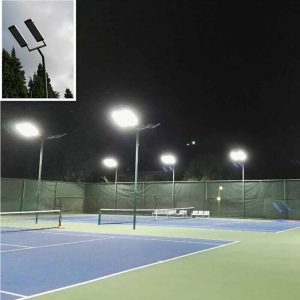 The color rendering index is above 75, and the LED can be turned on instantly. The light efficiency is 90-1001m / w. The LED has no ultraviolet content and no flicker. No glare, use 6-15 meters in height. LED lights are more widely used. Stadium commercial super, factory, warehouse, garage pole, LED working life is 30,000 hours. Power factor is above 0.95. Low starting current. Operating voltage range 90 265V.
The color rendering index is above 75, and the LED can be turned on instantly. The light efficiency is 90-1001m / w. The LED has no ultraviolet content and no flicker. No glare, use 6-15 meters in height. LED lights are more widely used. Stadium commercial super, factory, warehouse, garage pole, LED working life is 30,000 hours. Power factor is above 0.95. Low starting current. Operating voltage range 90 265V.
Light weight, small size and small wind load coefficient. The lamp should have its own or attached angle rotation indicating device to facilitate the adjustment of the projection angle. Energy-saving lighting sources should meet the requirements of high light efficiency, long life, energy saving, and environmental protection. At the same time, they should have good color rendering and suitable color temperature parameters. In places where the lamps are high, the light source should preferably be led. Color rendering and correlated color temperature of light sources and corresponding applications.
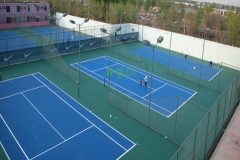 Metal halide lighting effect 70-100 lm/ m. The color rendering index of metal halide lamps is about 65. The start-up time of metal halide lamps is 5 to 10 minutes. Metal halide lamps have an ultraviolet content of 34%. Metal halide lamps are not suitable for direct use at high distances. The flicker is severe to the naked eye and the glare is serious. The installation height is more than 8 meters, and there are no outdoor and high ceiling lamp places. Metal halide lamp life of 8000-12000 hours. The power factor is 0.8, the starting current is very high, and it has a large operating voltage range of 200-240V on the appliance. Traditional metal halide and sodium lamp light source to prevent strong ultraviolet radiation from hurting people.
Metal halide lighting effect 70-100 lm/ m. The color rendering index of metal halide lamps is about 65. The start-up time of metal halide lamps is 5 to 10 minutes. Metal halide lamps have an ultraviolet content of 34%. Metal halide lamps are not suitable for direct use at high distances. The flicker is severe to the naked eye and the glare is serious. The installation height is more than 8 meters, and there are no outdoor and high ceiling lamp places. Metal halide lamp life of 8000-12000 hours. The power factor is 0.8, the starting current is very high, and it has a large operating voltage range of 200-240V on the appliance. Traditional metal halide and sodium lamp light source to prevent strong ultraviolet radiation from hurting people.
3. The technical comparison
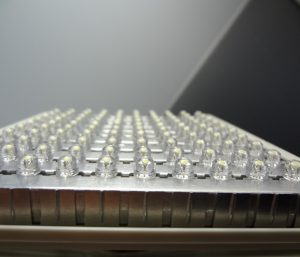 a. Power consumption
a. Power consumption
Due to the use of inductive ballasts, the full picture lamp has high power consumption, painful work, and a very high starting current between Kaiyuan, such as 400; the metal halide is as high as about 15A at the moment of starting the shed, which has a great impact on the life of the appliance. Air is often damaged when opening the box. The attached ballast itself consumes a lot of power, which causes huge electricity expenses for the first user and accelerates the aging time of the line. Because the LED uses a constant current driver, the power consumption is low and the power factor is high to avoid the above problems.
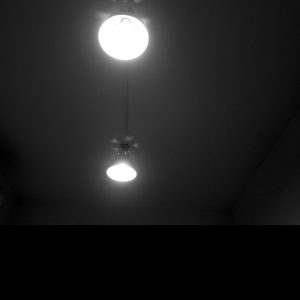 b. Color rendering index
b. Color rendering index
It is an important parameter that the light source considers her weight. Color refers to high instruction. When you look at things clearly, the colors are real. On the contrary, when you look at things under the lights, the lines are blurred and the objects are distorted. Metal halide lamp 65, color rendering is low. Working under these light sources can easily cause myopia and visual fatigue.
c. UV content
Ultraviolet light is a kind of scared light, which can cause serious damage to eyes and skin, and can cause eye diseases and skin cancer. The content of traditional UV light is very high, such as metal halide lamps, and the outside line contains the total luminous flux: working under metal halide lamps at a close distance can cause considerable harm to the human body. L4D does not contain ultraviolet rays.
d. Instant on/off instantly
After the metal halide lamp is turned off, it needs to wait for a period of time after 10 minutes before it can be restarted, otherwise it will be burned and bring a lot of inconvenience to the user.
e. Glare-free
It is a kind of light pollution, which is caused by the light source itself or improper matching of the light source and the lamp. Working under glare can cause visual fatigue and visual errors, and is also the main cause of myopia. Metal halide lamps due to light refraction caused by uneven manufacturing of glass bulbs, so their own glare is very serious, and they are all point light sources, and it is easy to form a focal point to cause glare when matched with lamps.
f. Strobing-free
It is a kind of light pollution, which is caused by the periodic change in the light flux of the point light source with the AC voltage. Strobe is the “invisible killer” of the lighting environment and can cause myopia and migraine headaches. The strobe of metal halide lamps is very serious. Human eyes will feel the flash of light, which will cause great damage to the human visual system. The LED does not flicker because it rectifies AC into DC, and the DC voltage does not change periodically.
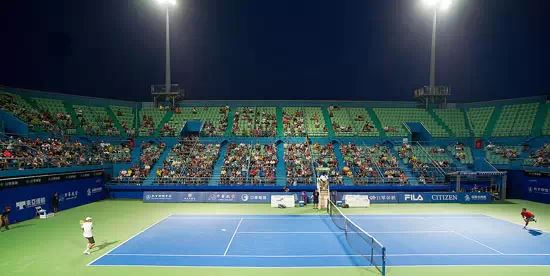 It can be seen that the unique reflector design of LED lamps can reach 90-95% efficiency; it is convenient for flexible lighting and light distribution design to achieve energy saving; cooperate with professional high-hanging long-life led light sources to achieve higher lumen maintenance and Longer life; high efficiency and energy saving, led flood light does not contain harmful substances and protects the environment. It will not cause harm to the human body. High stability, long life and high safety factor Compared with traditional metal halide lamps, energy saving can reach 50-60%. Therefore, the light source of the tennis court lighting should be LED lighting.
It can be seen that the unique reflector design of LED lamps can reach 90-95% efficiency; it is convenient for flexible lighting and light distribution design to achieve energy saving; cooperate with professional high-hanging long-life led light sources to achieve higher lumen maintenance and Longer life; high efficiency and energy saving, led flood light does not contain harmful substances and protects the environment. It will not cause harm to the human body. High stability, long life and high safety factor Compared with traditional metal halide lamps, energy saving can reach 50-60%. Therefore, the light source of the tennis court lighting should be LED lighting.
 The current reasonable level of investment in tennis court lighting is reflected in the performance-price ratio, that is, the total number of lights used, the total power consumption, the failure rate of the tennis court lighting, and the quality of a tennis court to achieve the lighting design quality target A comprehensive comparison with the investment in tennis court lighting.
The current reasonable level of investment in tennis court lighting is reflected in the performance-price ratio, that is, the total number of lights used, the total power consumption, the failure rate of the tennis court lighting, and the quality of a tennis court to achieve the lighting design quality target A comprehensive comparison with the investment in tennis court lighting.
During the competition, if the lighting effect is not up to standard, it will seriously affect the athlete’s condition. The most prominent performance is that the ball can’t be seen by the light, and even endangers the health of the athlete. So from a professional perspective. It not only meets the needs of competition at all levels, but also implements thrift and reduces costs. Of course, the scientific configuration of tennis court lighting is inseparable from the choice of lamps. Ordinary lamps are difficult to match the lighting requirements of tennis courts because of their versatility, so the lamps used as tennis court lighting must be professionally customized. For tennis courts where the installation height of the lamps is high, tennis court-specific LED lights are used. For indoor tennis courts with lower ceilings and smaller areas, it is advisable to use small-power, low-color-temperature tennis court-specific LED flood lights.
The power of the light source should be appropriate to the size, installation location and height of the playing field. When using LED lamps, the color temperature of the light source should not be greater than 6000K, and the color tolerance of similar light sources should not be greater than 5 SDCM. The deviation of the chromaticity coordinates of the LED lamp from the initial value during the lifetime is in the national standard “Uniform color space and color difference formula 》 GB / T 7921-2008 CIE1976 uniform chromaticity scale chart shall not exceed 0.004.

